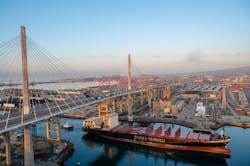774-ft Container Ship bunkered with 300K gallons of LNG for West Coast routes
Pasha Hawaii is putting its first liquified natural gas-fueled container ship into operation after LNG was supplied to the vessel at a U.S. West Coast port.
The new MV George III was bunkered with LNG and the first container ship to do so there at the Port of Long Beach, according to supplier Clean Energy Fuels Corp. The company worked with World Fuel Services and West Coast Clean Fuels to supply the MV George III with more than 300,000 gallons of LNG fuel, lower emitting than diesel.
“The air quality around the Ports of Long Beach and Los Angeles is some of the worst in the country because of in large part the very dirty marine fuels that have been traditionally used by container ships,” said Andrew J. Littlefair, president and CEO, Clean Energy. “The move by Pasha to add ships that operate on clean-burning LNG is one the most forward-thinking and environmentally progressive actions taken in the maritime industry. We congratulate Pasha on their first successful bunkering operation and look forward to many more as Pasha continues to add the other LNG-powered ships to their fleet.”
The 774-foot MV George III operates routes between Long Beach and Oakland, California and Honolulu. It is the first of three LNG-powered ships that Pasha Hawaii plans to put into service.
Altogether, the three vessels are forecast to consume about 105 million gallons of LNG fuel over the next five years. The U.S. is now the world’s largest exporter of LNG, in which U.S. natural gas is chilled to colder than minus 260 degrees F. to liquify it and make stable for shipping.
See more EnergyTech coverage on Liquified Natural Gas and its role in the C&I Energy Transition
JERA, Uniper plan LNG-Ammonia projects along U.S. Gulf Coast
Subscribe to our free, tri-weekly newsletters for regular Insights into the C&I Decarbonization Path
Proponents say that LNG-powered ships reduce diesel particulate matter and sulfer oxide emissions by 99 percent, nitrogen oxide by 90 percent and a quarter less carbon dioxide compared to traditional shipping fuels.
The Clean Energy Fuels LNG is supplied from the company’s plant in Boron, Calif. The facility will be expanded 50 percent when a third liquefaction-production train is completed in the near future, according to reports.
The MV George III is scheduled to bunker every second week at the Port of Long Beach. The second Pasha ship to operate on LNG, the Janet Marie, is expected to go into service in late 2022. The third Pasha ship is expected to be deployed in mid-2023.
A new report by the federal Energy Information Administration says that addition of three new major LNG terminal projects on the Gulf Coast should bring total U.S. LNG export capacity to nearly 17 billion cubic feet per day (bcf/d) over the next few years. Much of this product at these export facilities, which chill U.S. natural gas to liquify and make it stable for shipping, will go to customers in Europe, Asia and Africa.
The projects under construction are the Golden Pass, Plaquemines and Corpus Christi Stage III terminals. Altogether, they would add 5.7 bcf/d by 2025, according to the EIA.
---
(Rod Walton, senior editor for EnergyTech, is a 14-year veteran of covering the energy industry both as a newspaper and trade journalist. He can be reached at [email protected]).
Follow us on Twitter @EnergyTechNews_ and @rodwaltonelp and look us up on LinkedIn
About the Author
Rod Walton, EnergyTech Managing Editor
Managing Editor
For EnergyTech editorial inquiries, please contact Managing Editor Rod Walton at [email protected].
Rod Walton has spent 17 years covering the energy industry as a newspaper and trade journalist. He formerly was energy writer and business editor at the Tulsa World. Later, he spent six years covering the electricity power sector for Pennwell and Clarion Events. He joined Endeavor and EnergyTech in November 2021.
Walton earned his Bachelors degree in journalism from the University of Oklahoma. His career stops include the Moore American, Bartlesville Examiner-Enterprise, Wagoner Tribune and Tulsa World.
EnergyTech is focused on the mission critical and large-scale energy users and their sustainability and resiliency goals. These include the commercial and industrial sectors, as well as the military, universities, data centers and microgrids. The C&I sectors together account for close to 30 percent of greenhouse gas emissions in the U.S.
He was named Managing Editor for Microgrid Knowledge and EnergyTech starting July 1, 2023
Many large-scale energy users such as Fortune 500 companies, and mission-critical users such as military bases, universities, healthcare facilities, public safety and data centers, shifting their energy priorities to reach net-zero carbon goals within the coming decades. These include plans for renewable energy power purchase agreements, but also on-site resiliency projects such as microgrids, combined heat and power, rooftop solar, energy storage, digitalization and building efficiency upgrades.

